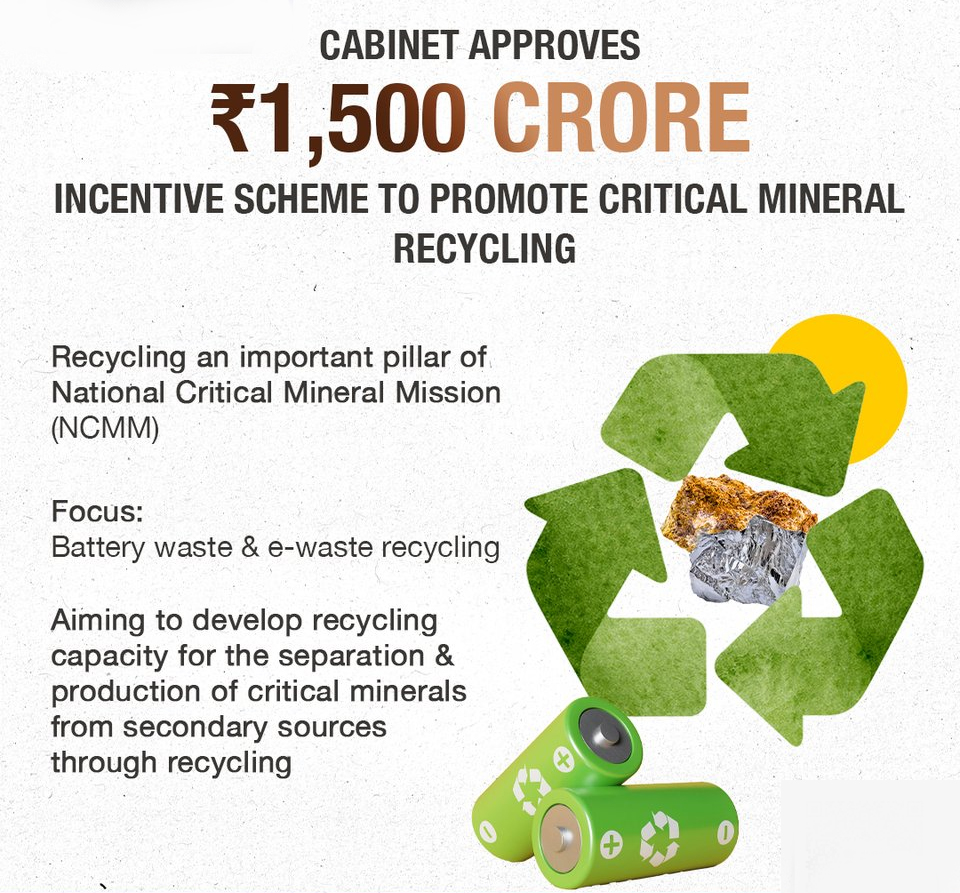Context:
On September 3, 2025, the Union Cabinet approved a ₹1,500 crore (US$ 170.4 million) incentive scheme under the National Critical Mineral Mission (NCMM). The goal is to promote recycling of e-waste and battery waste to extract critical minerals such as lithium, cobalt, and nickel. The scheme will run from FY2025-26 to FY2030-31.
Key Objectives of the Scheme:
The scheme aims to:
· Develop 270 kilotonnes/year of recycling capacity
· Extract 40 kilotonnes/year of critical minerals
· Attract ₹8,000 crore in private investment
· Create around 70,000 jobs, directly and indirectly
Focus of the Scheme
The scheme promotes recycling of:
· E-waste
· Lithium-ion battery (LIB) scrap
· Catalytic converters from old vehicles
It aims to extract critical minerals like lithium, cobalt, and nickel to reduce import dependence and support clean energy supply chains. Both large and small recyclers, including start-ups, are eligible. One-third of the funds are reserved for small/new players.
Financial Support
Two types of subsidies are offered:
· Capex: 20% subsidy on machinery for timely production; reduced benefits for delays
· Opex: Linked to incremental sales over FY2025-26, paid in two stages—40% in FY2026-27 and 60% in FY2030-31
Incentive limits:
· Large units: Up to ₹50 crore (₹10 crore Opex cap)
· Small units: Up to ₹25 crore (₹5 crore Opex cap)
About Critical minerals:
Critical minerals are non-fuel minerals essential for modern technologies, economic development, and national security, whose supply chains are vulnerable to disruption. Their criticality is determined by their economic importance and the potential risks to their supply
Key Critical Minerals and Their Uses
· Lithium: Vital for rechargeable batteries in EVs, laptops, and phones. Sourced from brines and pegmatites.
· Cobalt: Used in EV batteries, alloys, and aerospace parts. Mainly sourced from the Democratic Republic of the Congo.
· Graphite: Key battery anode material; also used in lubricants and high-temperature applications.
· Rare Earth Elements (REEs): Crucial for EV motors, wind turbines, and electronics. China leads global processing.
· Copper: Essential for electrical wiring, solar panels, and EVs—core to energy infrastructure.
· Niobium & Tantalum: Used in aerospace alloys, electronics, and medical devices.
About National Critical Mineral Mission:
Launched in 2025, the National Critical Mineral Mission (NCMM) is a strategic initiative by the Government of India to secure long-term access to critical minerals vital for clean energy, technology, and defense sectors.
· With a total planned outlay of ₹34,300 crore—including ₹16,300 crore from the government and ₹18,000 crore from PSUs and private players—the mission spans seven years( 2025-31) and aims to reduce India’s heavy reliance on imports, especially from countries like China.
Conclusion:
This initiative is a major step toward strengthening India’s green economy by supporting sustainable supply chains for electric vehicles, batteries, and renewable energy systems. It encourages domestic innovation, reduces waste, and enhances supply security for critical technologies.







